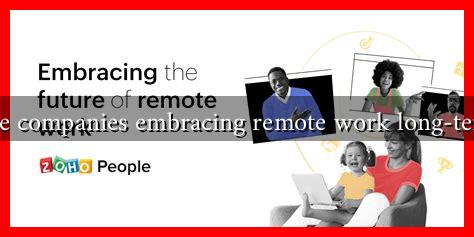-
Table of Contents
Are Companies Embracing Remote Work Long-Term?
The COVID-19 pandemic has fundamentally altered the way businesses operate, with remote work becoming a necessity rather than a choice. As we move into a post-pandemic world, the question arises: are companies embracing remote work long-term? This article explores the current landscape of remote work, its benefits and challenges, and how various companies are adapting to this new normal.
The Shift to Remote Work
Before the pandemic, remote work was often viewed as a perk rather than a standard practice. However, the sudden shift in 2020 forced many organizations to adapt quickly. According to a report by Stanford University, remote work increased from 24% to 42% of the U.S. workforce during the pandemic. This shift has led to a reevaluation of traditional work models.
Benefits of Long-Term Remote Work
Many companies have discovered that remote work offers several advantages, including:
- Increased Productivity: A study by Prodoscore found that productivity among remote workers increased by 47% in 2020.
- Cost Savings: Companies can save on overhead costs such as office space, utilities, and supplies. For instance, a Global Workplace Analytics report estimates that employers can save an average of $11,000 per year for each employee who works remotely half of the time.
- Access to a Global Talent Pool: Remote work allows companies to hire talent from anywhere in the world, increasing diversity and expertise.
- Improved Employee Satisfaction: A survey by Buffer found that 98% of remote workers would like to work remotely at least some of the time for the rest of their careers.
Challenges of Remote Work
Despite its benefits, remote work also presents challenges that companies must address:
- Communication Barriers: Remote work can lead to misunderstandings and a lack of collaboration if not managed properly.
- Employee Isolation: Many remote workers report feelings of loneliness and disconnection from their teams.
- Work-Life Balance: The blurring of lines between work and personal life can lead to burnout if employees are not careful.
Case Studies: Companies Embracing Remote Work
Several companies have made significant strides in adopting remote work as a long-term strategy:
- Twitter: In 2020, Twitter announced that employees could work from home indefinitely if they choose. This decision reflects the company’s commitment to flexibility and employee well-being.
- Shopify: The e-commerce giant declared itself a “digital by default” company, allowing employees to work remotely permanently. This shift has enabled Shopify to focus on building a robust remote work culture.
- Microsoft: The tech giant has implemented a hybrid work model, allowing employees to choose their work environment. This approach combines the benefits of in-office collaboration with the flexibility of remote work.
The Future of Remote Work
As companies continue to navigate the post-pandemic landscape, the future of remote work appears promising. According to a survey by McKinsey, 52% of employees prefer a hybrid work model, combining remote and in-office work. This trend suggests that companies will need to adapt their policies to meet employee expectations.
Moreover, organizations are investing in technology and tools to facilitate remote work, such as collaboration software, project management tools, and virtual communication platforms. These investments are crucial for maintaining productivity and engagement in a remote work environment.
Conclusion
In conclusion, the shift to remote work is not just a temporary response to the pandemic; it is a long-term trend that many companies are embracing. While there are challenges to overcome, the benefits of increased productivity, cost savings, and employee satisfaction make a compelling case for remote work. As organizations continue to adapt, the future of work will likely be a hybrid model that combines the best of both worlds. Companies that invest in their remote work strategies will not only attract top talent but also foster a more engaged and satisfied workforce.
For more insights on remote work trends, you can visit Gartner.


